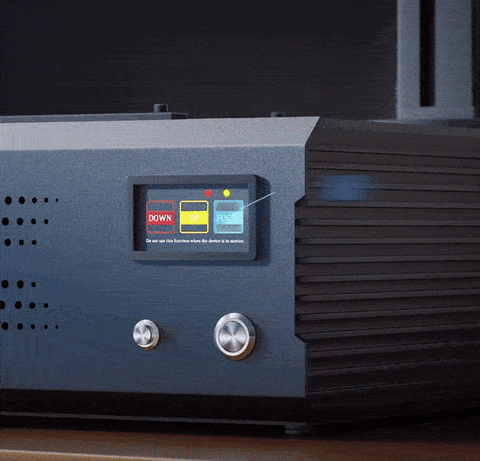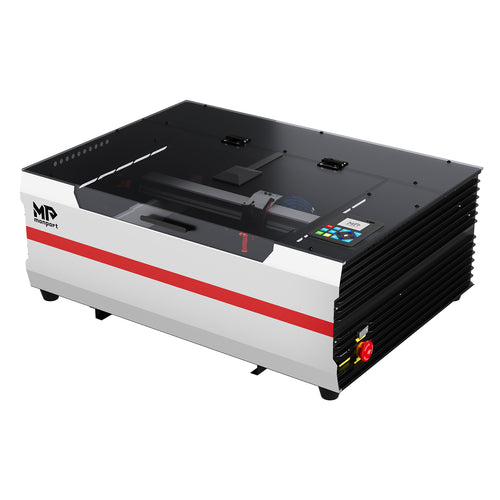Industrial laser cutter and fiber laser marking machines have revolutionized metalworking and engraving industries. Their precision, speed, and versatility empower businesses to create intricate designs and markings on a wide range of materials. But navigating the complexities of these machines, particularly settings and troubleshooting, can be daunting.
This comprehensive guide from Monport, unpacks industrial laser cutters and fiber laser marking machines, equipping you with the knowledge to unlock their full potential.
| GPro Series MOPA | GA Series MOPA | GQ Series Machine | GP Series Machine | GI Series MOPA |
 |
Understanding Industrial Laser Cutters and Fiber Laser Marking Machines
Industrial Laser Cutters:
- Utilize a high-powered laser beam to cut through various materials, including metal, plastic, wood, and more.
- Offer exceptional precision and accuracy, often used for intricate designs and complex shapes.
- Provide significant production speed compared to traditional cutting methods, streamlining workflows.
Fiber Laser Marking Machines
- Employ a focused laser beam to mark metal surfaces with permanent designs, logos, or text.
- Offer superior detail and control, ideal for creating precise markings, codes, or even artistic engravings.
- Can achieve a wider range of marking effects compared to traditional methods like stamping or etching.
Monport Fiber Laser: Your Trusted Partner in Laser Technology
Monport offers a diverse range of industrial laser cutters and fiber laser marking machines to cater to various needs. Here's a glimpse into some of their popular models:
| GPro Series MOPA | GA Series MOPA | GQ Series Machine | GP Series Machine | GI Series MOPA |
 |
- GPro Series MOPA: This state-of-the-art machine boasts a powerful 30W-100W fiber optic laser for precise engravings at speeds of up to 10,000mm/s. Its versatile MOPA technology allows for vibrant markings on various metals and intricate designs on plastic.
- GA Series MOPA: This all-in-one solution features a one-click autofocus system and rigorously tested components for exceptional stability and speed. The ±90° adjustable arm unlocks creative possibilities, allowing for diverse metal marking and cutting applications.
- GQ Series Machine: Experience high-speed metal engraving with this user-friendly machine. Its cutting-edge technology delivers precise results on various materials, including aluminum, stainless steel, and hard plastic.
- GP Series Machine: This compact and portable option is ideal for users seeking a lightweight and user-friendly metal marking solution.
- GI Series MOPA: Upgrade your laser marking capabilities with this machine. Experience vibrant color engraving, automatic air cooling, and portability, making it perfect for diverse applications.
A Guide to Industrial Laser Cutter and Fiber Laser Marking Machine Settings
While specific settings may vary based on the chosen machine and the material being processed, here's a breakdown of some key parameters to consider:

- Laser Power: This determines the intensity of the laser beam and its ability to cut or mark the material. Higher power settings are needed for thicker metals or deeper cuts.
- Pulse Width: This controls the duration of the laser pulse and impacts the depth and detail of the marking or cut. Shorter pulses create sharper details but may not penetrate deeply, while longer pulses offer deeper penetration but with less definition.
- Frequency: This refers to the number of laser pulses delivered per second. Higher frequencies can increase processing speed but might require adjustments to other settings for optimal results.
- Focus Distance: Maintaining the correct distance between the laser nozzle and the material is crucial for achieving clean cuts or precise markings. Most machines offer automatic focusing systems for ease of use.
- Assist Gas: An inert gas like nitrogen is often used during laser cutting to prevent oxidation and achieve clean edges. The gas pressure also plays a role, with higher pressure aiding in faster cutting and cleaner results.
Remember: It's always recommended to consult the user manual of your specific industrial laser cutter or fiber laser marking machine for detailed instructions and recommended settings for various materials. Additionally, experiment with test cuts or markings on scrap material before working on your final project.
Troubleshooting Common Industrial Laser Cutter and Fiber Laser Marking Machine Issues
Even with careful operation, occasional issues might arise. Here are some common problems and troubleshooting tips:
- Poor Cut Quality or Markings: This could be due to incorrect laser power settings, pulse width, or focus distance. Review your settings and experiment with adjustments on scrap material. Ensure the material is clean and free of contaminants.
- Excessive Smoke or Fumes: This might indicate insufficient assist gas flow or pressure. Check the gas supply and adjust pressure accordingly. Ensure proper ventilation in your workspace.
- Machine Overheating: Most machines have built-in safeguards to prevent overheating. However, consider checking for proper ventilation and ensure no debris is blocking vents. Allow the machine to cool down before resuming operation.
- Error Messages: Industrial laser cutters and fiber laser marking machines typically display error codes on the control panel. Consult the user manual for specific troubleshooting steps based on the displayed code.
- Laser Beam Misalignment: While uncommon, misalignment can occur. If you suspect this issue, refer to a qualified technician for inspection and realignment.
Safety First!
Industrial laser cutters and fiber laser marking machines are powerful tools. Here are some essential safety precautions to remember:
- Always wear laser safety glasses with the appropriate wavelength for your specific machine.
- Never stare directly into the laser beam, even with safety glasses on.
- Ensure proper ventilation in your workspace to remove fumes and smoke generated during operation.
- Keep flammable materials away from the machine's working area.
- Securely fasten the material being processed to prevent movement during operation.
- Only operate the machine after familiarizing yourself with all safety protocols and procedures.
Frequently Asked Questions (FAQs) about Fiber Laser Cutters and Industrial Laser Cutters
1. What are the advantages of fiber laser cutters compared to CO2 laser cutters?
Fiber laser cutters offer several advantages over CO2 laser cutters, particularly for metal processing:
- Superior Beam Quality: Fiber lasers produce a more focused beam, resulting in cleaner cuts and finer details on metals.
- Higher Efficiency: Fiber lasers offer greater energy conversion efficiency, translating to lower operating costs and higher productivity.
- Reduced Maintenance: Fiber lasers require minimal maintenance compared to CO2 lasers, reducing downtime and overall ownership costs.
- Wider Material Compatibility: While CO2 lasers excel with non-metals, fiber lasers can handle a broader range of metals, including highly reflective materials like aluminum and copper.
2. What factors should I consider when choosing between a fiber laser cutter and an industrial laser cutter?
The ideal choice depends on your specific needs:
- Material Type: If you primarily work with metals, a fiber laser cutter is the preferred option. For a wider range of materials, including non-metals like wood or plastic, an industrial laser cutter might be more versatile.
- Cutting Thickness: Consider the maximum thickness of material you need to cut. Fiber laser cutters generally excel at thinner metals, while industrial laser cutters can handle thicker materials depending on the model's power.
- Application Requirements: Evaluate the level of detail and precision required for your projects. Fiber lasers typically offer superior detail for intricate designs on metals.
3. Can fiber laser marking machines create colored markings on metal?

Yes, some advanced fiber laser marking machines utilizing MOPA (Mode-locked Pulse Advantage) technology can achieve color marking effects on certain metals through a process called laser-induced oxidation. The laser beam alters the surface oxide layer of the metal, creating color variations depending on the material and laser parameters.
4. What software is typically used with industrial laser cutters and fiber laser marking machines?

Most machines are compatible with industry-standard design and laser control software like LightBurn and EzCad. These programs allow you to create designs, define laser settings, and control the cutting or marking process.
5. Where can I find training or resources to learn more about operating industrial laser cutters and fiber laser marking machines?
Many laser cutter and marking machine manufacturers offer training resources, online tutorials, and user manuals to help you learn the basics of operating the machine. Additionally, online communities and forums dedicated to laser cutting and marking can provide valuable insights and troubleshooting tips.
By understanding these FAQs and the information provided in this comprehensive guide, you can confidently navigate the world of industrial laser cutters and fiber laser marking machines. Unlock a new level of precision, speed, and creative freedom in your metalworking and engraving projects.
Conclusion
By understanding the capabilities of industrial laser cutters and fiber laser marking machines, along with proper settings, troubleshooting techniques, and safety precautions, you are well-equipped to unlock their full potential. Explore the Monport Fiber Laser range to discover the perfect machine for your metalworking and engraving needs. From the versatile GPro Series MOPA to the user-friendly GP Series, Monport offers a solution to empower your creativity and streamline your workflow.
Visit the Monport website today to explore their wide range of industrial laser cutters and fiber laser marking machines. With detailed product information, educational resources, and exceptional customer support, Monport is your trusted partner in the world of laser technology. Transform your metalworking and engraving projects with precision, speed, and unmatched quality!












